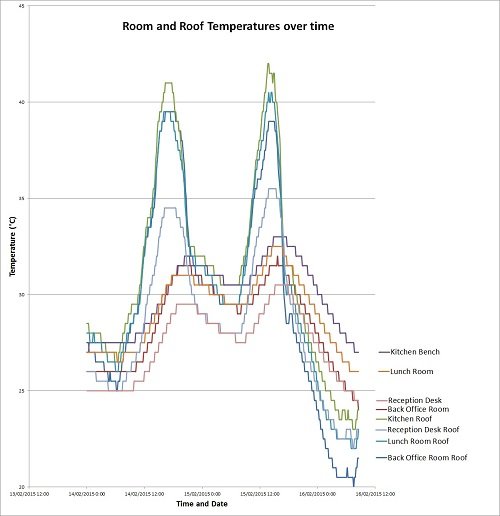Does the position of the sun change room/roof temperature?
Does the position of the sun change room/roof temperature? |
 | How does where the sun hits a building affect its internal roof temperature and office temperature? With the rising cost of utilities and a strong want for a cool home/office, the Scientists here at Instrument Choice decided to see if there is a significant difference between the roof space and various offices at the Instrument Choice premises. Our main interest was to see if there was a significant variation to the north facing and south facing side to determine if where the sun fell throughout the day had a higher effect within certain areas. Read on to find out the results! | |
| Equipment - 8 x EL-USB-1 Temperature Data Loggers Method EL-USB-1 Temperature data loggers were fitted to 4 areas within the office space. 4 were fitted within the roof space and 4 were fitted in various offices. Each of the loggers was set to record every 30 minutes and were left in the roof space over a period of 2 days. The loggers were left in place over the weekend as this is when air conditioning was turned off and as such gave a much clearer picture as to the effects of the sun in various areas. There is a diagram below showing were the loggers were fitted. The data was then examined to determine the differences based on location of the sun between internal and roof space temperatures.  Figure 1: Diagram showing where loggers were fitted within the office area Results  Figure 2: Graphical representation of the temperature of the various areas over time  Figure 3: Table reflecting the maximums reached in each area Discussion and Conclusion These results show that the reception desk area maintained the lowest temperature at its maximum temperature reached when compared with the other areas. It was 4°C lower than its next closest roof counterpart and 1.5°C lower than its office counterpart. This is due to where the sun falls throughout the day with it receiving the least amount of afternoon sun and a small amount of morning sun as it is largely shaded by an existing building. The area that reached the highest temperature was the kitchen area which was expected as it is completely North facing and receives the largest amount of afternoon sun. It is interesting to note that all of the roof spaces and office spaces reflected an ~10°C difference showing the significant difference insulation makes to keeping an area cool. The graph also shows that the office areas which are insulated warm and cool at a much more consistent rate when compared with the uninsulated roof areas. The results indicate that where the sun falls does have a significant effect on roof and office space throughout the course of a day and with planning such as double glazing of windows, thicker insulation and roof pitch the effects could be further minimised. If you would like to discuss this experiment further please contact one of our friendly Scientists via email or phone on 1300 737 871. Daniel Craig McGaffin | ||
Contact our expert scientists now to get the right meter or data logger to suit your needs and discuss your project.
Phone: 1300 737 871
Email: [email protected]
